2018年國際玻璃技術大展(Glasstec 2018)預定於10月在德國杜塞道夫舉行,本次主題將鎖定讓玻璃產業轉型為智慧工廠的初步成果,其中包括自動化如何改變製程以及玻璃產業轉型也需要政策配合。
據Glass On Web報導,工業4.0風潮同樣也衝擊到玻璃生產、處理與裝訂。由工業4.0趨勢所帶來的變革,是讓整個工業價值鏈成為數位化與連網。同時物聯網(IoT)也代表所有供應商與客戶都會被整合在虛擬網路裡,讓即使很小的訂單也可立即啟動並提出精準的交貨時間。
由於工廠內與供應商的材料庫存都可同步被檢查,於是可進一步提出製造時程。在上述彈性的製造環境下,機器也可規劃維修間隔,讓當機可因此避免。如此代表智慧工廠產品可處理製造流程,甚至控制自己的品質,而人類則被智慧訓練與輔助系統協助,間接形成一個大型網路。
德國經濟部(Ministry of Economics)研究結果曾指出,當地高達7成中小企業已開始密切關注工業4.0概念。不過,並非所有廠商對工業4.0定義都一致,而且玻璃製造商的需求與窗戶製造商及玻璃裝訂商不同,但兩者都已逐步引進智慧工廠,例如採購新的機械與製造機器人。
在日漸自動化與數位化製程中,軟體扮演重要角色。在處理現場,必須有高效軟體能對所有機器說話並與外部保持聯繫。讓數位領域的各部門使用的統一語言與介面,也需要一個可靠的資料庫。
在該網路中,主軟體執行控制中心的功能,軟體收集新的客戶訂單、處理與協調所有機器數據。換言之,訂單處理、維修與機器故障通報,都會透過中央控制軟體處理與管理。
在數位化製程中,每一個工作站螢幕可呈現需要的生產數據,狀態報告則可隨時隨地取得,代表所有製程都透明化,也可望得以執行更多品質控管。在玻璃處理中,雷射技術逐漸被廣泛採用,頂級的雷射裝訂中心通常都會滿足數位製程的要求。
雷射被用在極高品質玻璃片雕刻上,透過雷射任何圖案設計、影像或照片都可刻在玻璃片上,同樣的雷射也可用在執行鑽孔與切割流程或尖角切除。自動化讓諸如雷射或製造機器人等現代機械可不間斷運作,也間接產生更多專門技術人員職缺的需求出現。
雖然業者面對的改變是逐步,但玻璃部門仍經歷根本的改變。德國政策制定者在2016年初成立SME-4.0 Centres of Expertise,其任務是在工業4.0與數位化中陪伴中小企業。
The term Industry 4.0 has been on everyone’s lips for some time now. It is synonymous with digitalisation and connection of the complete industrial value chain.
After dramatic developments at beginning of the industrial age such as the introduction of the steam engine, assembly line and later IT, the 4th Industrial Revolution is now marked by more and more smart factories.
This change does not stop short of glass production, processing and finishing either. Many exhibitors at glasstec 2018 in Düsseldorf will therefore focus on the theme of Industry 4.0 and exhibit interesting developments.
Incidentally, the term “Industry 4.0” was already invented as early as in 2011 on the occasion of the Hannover Fair.
The truly revolutionary thing about this trend, however, is the digitalisation and connection of the entire industrial value chain – from order entry and upstream supplies orders to manufacturing and complete logistics.
And when experts talk of the Internet of Things, this also means that the connection, of course, is no longer limited to your own “four factory walls”. All your suppliers and customers are also incorporated into this virtual network. This makes it possible to trigger order processes immediately and to state precise delivery times for even the smallest of batch sizes.
Because both your material inventories and those of your suppliers are checked almost simultaneously to verify and/or lay down manufacturing timetables. In such a flexible production environment machines also plan their own maintenance intervals scheduling them in production breaks and over the weekend. Down times are to be avoided if possible.
This means that at smart factories products can handle their own manufacturing process and even control their own quality assurance. Humans are assisted by smart training and assistance systems in their increasingly complex job routines and, needless to say, form part of this giant network.
For many this will probably still sound like wishful thinking but it is increasingly real. After all, those not worrying about this today, will probably be ousted of the market tomorrow. Therefore, it comes as no surprise that some 70% of all SMEs are currently taking a very close look at Industry 4.0 concepts, says a study commissioned by the Ministry of Economics.
However, not all of them define Industry 4.0 in the same way. And, naturally, the requirements made on glass manufacturers differ from those made on window producers or finishers.
But both supposedly convert their outfits into smart factories in small steps such as the purchase of new machinery or manufacturing robots. But the changeover is inevitable since new technologies are more efficient thereby increasing competitiveness while cutting costs.
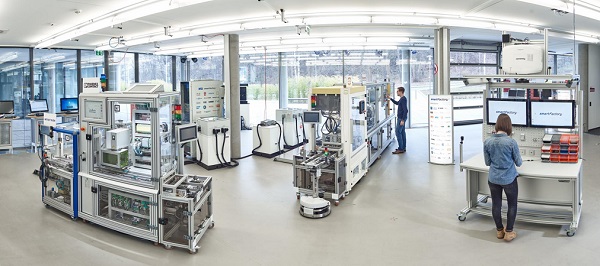 So as to increase flexibility manufacturing is distributed to production islands in the model smart factory of the Technology Initiative. | Photo: SmartFactory / C. Arnoldi
So as to increase flexibility manufacturing is distributed to production islands in the model smart factory of the Technology Initiative. | Photo: SmartFactory / C. Arnoldi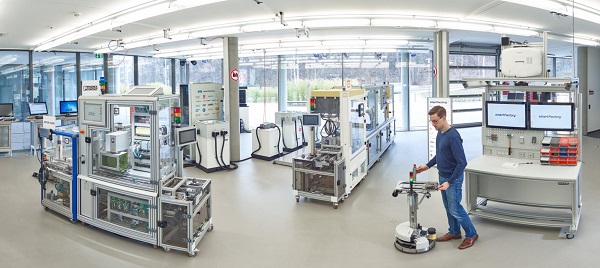 On the Industry 4.0 line a flexible transport system forwards every product to be finished to the relevant further processing station. | Photo: SmartFactory / C. Arnoldi
On the Industry 4.0 line a flexible transport system forwards every product to be finished to the relevant further processing station. | Photo: SmartFactory / C. Arnoldi
Interface: Software
In this increasingly automated and digitalised production process software plays a key role because it is these programs that enable communication and digital connection.
At a processor’s site, for example, there must be a high-performance overriding software that virtually “talks” to all machines while “staying in touch” with the outside world that also forms part of the network.
Alongside a common language and the respective interfaces the digital interplay of all parties involved also needs a sound database to work on. In this network the master software performs the function of an overriding control centre. The software collects incoming customer orders, processes and coordinates all machine data.
This means that order processes, maintenance and failure reports of the machines are also managed and handled by this central control software. To achieve perfect manufacturing capacity utilisation the software also assigns orders and items smartly and flexibly and, last but not least, also organises storage and logistics.
At a smart factory the software therefore has to feature virtually unlimited dovetailing options for networking. For many years the paperless office has been on everyone’s lips – but without any tangible success.
In the increasingly digitalised and automated production process low-paper and/or paperless manufacturing is already taken for granted today.
One example: at each workstation monitors display the required manufacturing data. Status reports can be retrieved at any time and any place. This means the whole process will become transparent – from the first to the last moment. And this also makes it possible to carry out more quality controls.
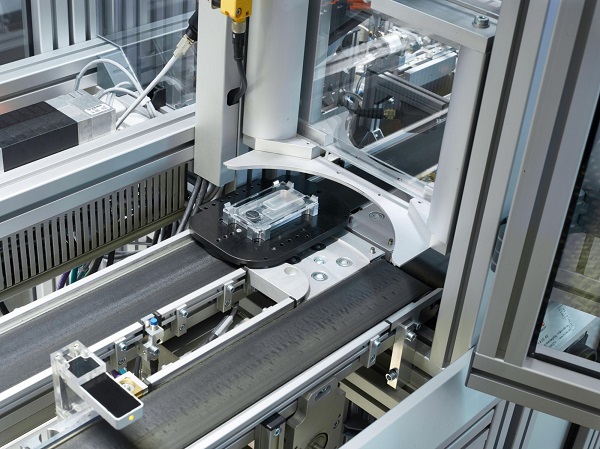
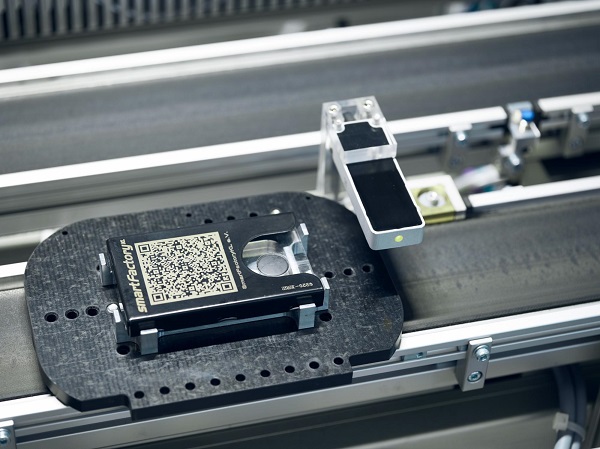 Jewellery photos for smart manufacturing. | Photos: SmartFactory / C. Arnoldi
Jewellery photos for smart manufacturing. | Photos: SmartFactory / C. Arnoldi
From Automation to Digitalisation
One example of change already taking place at many production sites is growing automation, which – in the figurative sense – can be seen as one step in the direction of Industry 4.0. In glass processing laser technology is being used to an increasing extent.
State-of-the-art laser finishing centres often meet all the needs of digitalised production. Lasers are used to apply extremely high-quality engravings to glass sheets. Any graphic design, any image or even any photo can be applied to glass sheets by means of lasering.
Around the globe it is architects, in particular, who are increasingly demanding that glass sheets are finished in this way as attractive and representative façade solutions for facilities. The same lasers can also perform drilling and cutting processes or edge deletion processes.
Permanent development of beam sources and improved software programs have increased processing speeds over the past few years and have also helped to put the oft lamented high power consumption in a perspective.
Automation enables modern machines such as lasers or manufacturing robots to operate practically round the clock and even at weekends. This necessarily also alters the demands made on the workforce. More and more specialists are called for in manufacturing because processes and tasks are becoming ever more complex.
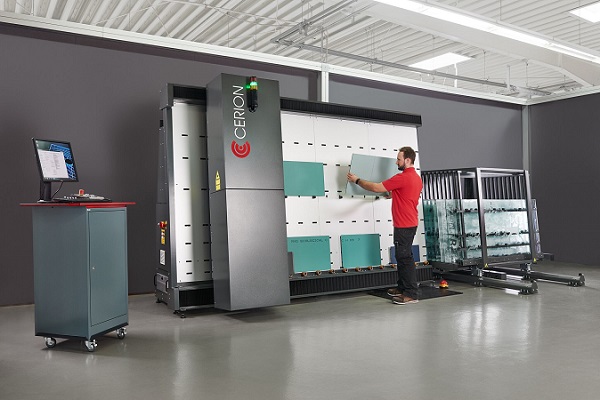 Laser finishing centres take automation one step further. At the same time, they often allow integration in smart production. | Photo: Cerion
Laser finishing centres take automation one step further. At the same time, they often allow integration in smart production. | Photo: Cerion